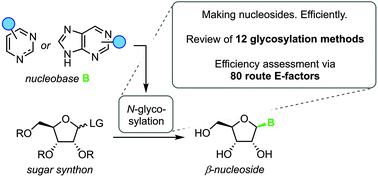当前位置:
X-MOL 学术
›
Green Chem.
›
论文详情
Our official English website, www.x-mol.net, welcomes your
feedback! (Note: you will need to create a separate account there.)
Route efficiency assessment and review of the synthesis of β-nucleosides via N-glycosylation of nucleobases
Green Chemistry ( IF 9.3 ) Pub Date : 2020-11-19 , DOI: 10.1039/d0gc02665d Felix Kaspar 1, 2, 3, 4, 5 , M. Rhia L. Stone 6, 7, 8, 9, 10 , Peter Neubauer 1, 2, 3, 4, 5 , Anke Kurreck 1, 2, 3, 4, 5
Green Chemistry ( IF 9.3 ) Pub Date : 2020-11-19 , DOI: 10.1039/d0gc02665d Felix Kaspar 1, 2, 3, 4, 5 , M. Rhia L. Stone 6, 7, 8, 9, 10 , Peter Neubauer 1, 2, 3, 4, 5 , Anke Kurreck 1, 2, 3, 4, 5
Affiliation

|
Nucleosides and their analogs are biomolecules central to nearly all areas of life science. Consequently, a variety of approaches have been developed to prepare these compounds. These methods typically employ N-glycosylation as a key step which installs a sugar moiety on a heterocyclic nucleobase. However, these methods vary drastically regarding their synthetic strategy, number of steps, yield, reagents, and conditions employed, making it difficult to compare and evaluate different approaches. Herein, we review the state of art for the synthesis of β-nucleosides by N-glycosylation and present a comprehensive sustainability assessment of these routes via an E-factor analysis. Our data reveal that the current methods and protocols are, in general, laborious and inefficient. Although impressive yields have been achieved in many cases, these typically came at the cost of long routes, leading to high overall E-factors (primarily composed of solvent contributions). Shorter routes using fewer protecting groups tended to perform equally well or better regarding their route E-factors, despite lower yields in many cases. Nearly all available approaches are currently hampered by a heavy reliance on chromatography, multiple protecting groups and bulky leaving groups. Biocatalytic methods bypass these limitations but suffer from poor substrate solubility and unfavorable reaction equilibria. To enable more efficient and sustainable nucleoside synthesis via N-glycosylation, future efforts should focus on using non-chromatographic purification steps, running shorter routes and higher substrate loading to minimize (solvent) waste accumulation.
中文翻译:

路线效率评估和通过核碱基的N-糖基化合成β-核苷的综述
核苷及其类似物是生命科学几乎所有领域的核心生物分子。因此,已经开发了多种方法来制备这些化合物。这些方法通常采用N-糖基化作为关键步骤,其将糖部分安装在杂环核碱基上。但是,这些方法在其合成策略,步骤数,收率,试剂和所用条件方面存在很大差异,因此很难比较和评估不同方法。本文中,我们回顾了通过N-糖基化合成β-核苷的最新技术,并通过以下方法对这些途径进行了全面的可持续性评估电子因子分析。我们的数据表明,当前的方法和协议通常是费力且效率低下的。尽管在许多情况下已经实现了令人印象深刻的产量,但这些产量通常是以漫长的路线为代价的,从而导致较高的总体E因子(主要由溶剂贡献构成)。尽管在许多情况下产率较低,但使用较少保护基的较短路线往往在其路线E因子方面表现相同或更好。目前,几乎所有可用的方法都严重依赖色谱法,多个保护基和庞大的离去基团。生物催化方法绕过了这些限制,但是底物溶解性差并且反应平衡不利。通过N实现更有效和可持续的核苷合成-糖基化,未来的工作应集中在使用非色谱纯化步骤,运行较短的路线和更高的底物负载以最小化(溶剂)废物的积累。
更新日期:2020-12-17
中文翻译:

路线效率评估和通过核碱基的N-糖基化合成β-核苷的综述
核苷及其类似物是生命科学几乎所有领域的核心生物分子。因此,已经开发了多种方法来制备这些化合物。这些方法通常采用N-糖基化作为关键步骤,其将糖部分安装在杂环核碱基上。但是,这些方法在其合成策略,步骤数,收率,试剂和所用条件方面存在很大差异,因此很难比较和评估不同方法。本文中,我们回顾了通过N-糖基化合成β-核苷的最新技术,并通过以下方法对这些途径进行了全面的可持续性评估电子因子分析。我们的数据表明,当前的方法和协议通常是费力且效率低下的。尽管在许多情况下已经实现了令人印象深刻的产量,但这些产量通常是以漫长的路线为代价的,从而导致较高的总体E因子(主要由溶剂贡献构成)。尽管在许多情况下产率较低,但使用较少保护基的较短路线往往在其路线E因子方面表现相同或更好。目前,几乎所有可用的方法都严重依赖色谱法,多个保护基和庞大的离去基团。生物催化方法绕过了这些限制,但是底物溶解性差并且反应平衡不利。通过N实现更有效和可持续的核苷合成-糖基化,未来的工作应集中在使用非色谱纯化步骤,运行较短的路线和更高的底物负载以最小化(溶剂)废物的积累。









































 京公网安备 11010802027423号
京公网安备 11010802027423号